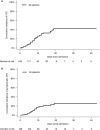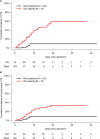Incidence of venous thromboembolism in hospitalized patients with COVID-19
- PMID: 32369666
- PMCID: PMC7497052
- DOI: 10.1111/jth.14888
Incidence of venous thromboembolism in hospitalized patients with COVID-19
Abstract
Background: Coronavirus disease 2019 (COVID-19) can lead to systemic coagulation activation and thrombotic complications.
Objectives: To investigate the incidence of objectively confirmed venous thromboembolism (VTE) in hospitalized patients with COVID-19.
Methods: Single-center cohort study of 198 hospitalized patients with COVID-19.
Results: Seventy-five patients (38%) were admitted to the intensive care unit (ICU). At time of data collection, 16 (8%) were still hospitalized and 19% had died. During a median follow-up of 7 days (IQR, 3-13), 39 patients (20%) were diagnosed with VTE of whom 25 (13%) had symptomatic VTE, despite routine thrombosis prophylaxis. The cumulative incidences of VTE at 7, 14 and 21 days were 16% (95% CI, 10-22), 33% (95% CI, 23-43) and 42% (95% CI 30-54) respectively. For symptomatic VTE, these were 10% (95% CI, 5.8-16), 21% (95% CI, 14-30) and 25% (95% CI 16-36). VTE appeared to be associated with death (adjusted HR, 2.4; 95% CI, 1.02-5.5). The cumulative incidence of VTE was higher in the ICU (26% (95% CI, 17-37), 47% (95% CI, 34-58), and 59% (95% CI, 42-72) at 7, 14 and 21 days) than on the wards (any VTE and symptomatic VTE 5.8% (95% CI, 1.4-15), 9.2% (95% CI, 2.6-21), and 9.2% (2.6-21) at 7, 14, and 21 days).
Conclusions: The observed risk for VTE in COVID-19 is high, particularly in ICU patients, which should lead to a high level of clinical suspicion and low threshold for diagnostic imaging for DVT or PE. Future research should focus on optimal diagnostic and prophylactic strategies to prevent VTE and potentially improve survival.
Keywords: COVID-19; critically ill; low-molecular-weight heparin; pulmonary embolism; venous thrombosis.
© 2020 The Authors. Journal of Thrombosis and Haemostasis published by Wiley Periodicals LLC on behalf of International Society on Thrombosis and Haemostasis.
Figures


References
Publication types
MeSH terms
Substances
LinkOut - more resources
Full Text Sources
Other Literature Sources
Medical

